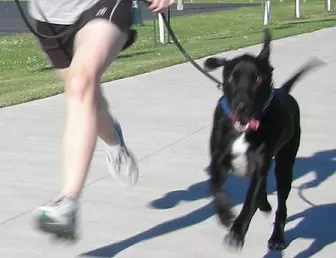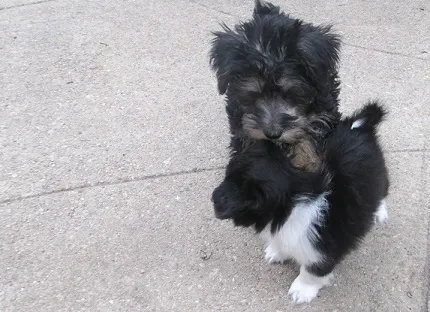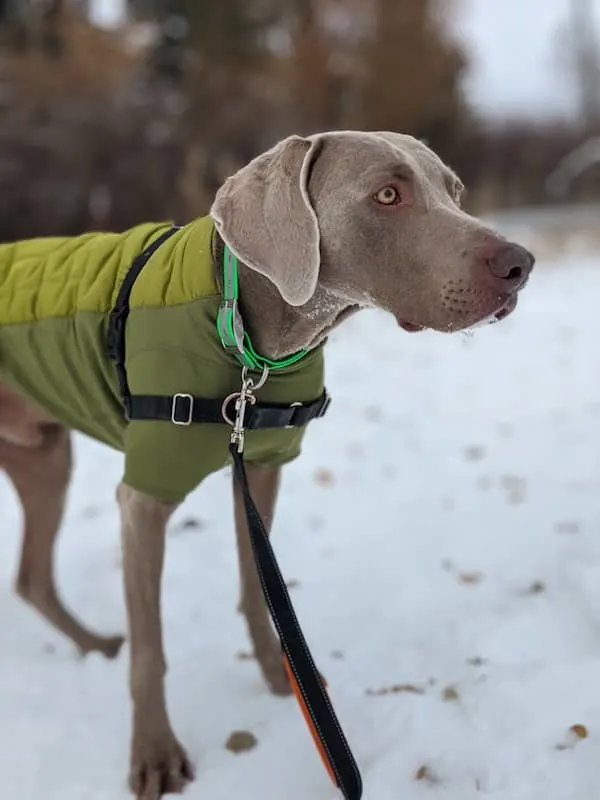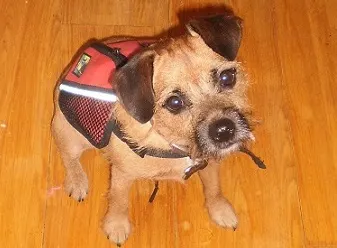A reader emailed me asking about on how to stop a dog from whining on walks. Her 17-pound Yorkie/schnauzer mix Apricot had been “squealing,” whining, barking and yanking on the leash every time they went for a walk.
Since this is such a common problem with dogs, I thought I’d tackle the topic in a post in case some of you would be willing to weigh in with your own experiences on how to stop a dog from whining and barking.
Of course, everything will be general advice and should be used for brainstorming. What works for one dog will not necessarily work for another dog.
The problem: dog keeps whining on walks
Here are some of the main points from the reader’s email:
“… as soon as we go past our driveway (with his leash on), he turns into a different puppy – he pulls, yanks, squeaks, squeals, high-pitched barks, I have tried lots of walks with him, running with him, playing in the backyard for energy release before walks, I tried the tight leash, the loose leash, etc….. it’s to the point where I dread taking him for walks …
“… the problem is the leash which brings the ‘anxiety’ or the ‘anxiousness’ that causes Apricot to just want to ‘run’ as soon as the leash is on him and when he has to ‘walk’ he can’t he pulls, yanks, squeaks, and squeals.”
How to stop the dog from barking and whining on walks:
It seems like Apricot is a high-energy, young dog who doesn’t know what to do with all his energy. When the leash is on, he gets anxious and frustrated because he wants to go-go-go!
The leash itself, in addition to being out in an exciting place, seems to be what brings out the anxiety/frustration. Apricot is pretty good off leash, according to his owner. He typically doesn’t bark or squeal when the leash is off and he generally stays close. When the leash is on, he starts the barking and yanking.
The owner has tried using treats, switching directions, choke collars, prong collars, a harness and different leashes.
My suggestions to stop the dog’s barking and whining at everything on walks:
1. Try a Gentle Leader or other training collar.
Try a variety of training collars until you find the best option for your specific dog that gives you the most control while keeping your dog safe. This reader had tried a prong collar and a choke collar with little success. She had also tried a harness.
When I’m personally dealing with highly anxious or vocal dog, a Gentle Leader or a Halti sometimes works well. These types of collars fit over the dog’s mouth, almost like a muzzle. But the dog is still able to pant and drink normally. Sometimes a Gentle Leader will help a strong, anxious dog stay more relaxed.
The Gentle Leader comes in a size small, which should work for the Snorkie breed mentioned earlier.
Another good option to try is the EasyWalk no-pull harness.
No matter what type of collar or harness you use, make sure your dog can not slip out! You may need to clip the leash to two spots to prevent some dogs from escaping.
For example, I clip my dog’s leash to his collar and his EasyWalk harness to prevent him from twisting out of his harness.
2. Maintain a routine for your dog.
Dogs love routine, and I find that they do settle down a bit if you can make life predictable for them. A routine could involve getting up at the time every morning, eating at this time every morning, heading out for a walk at this time, going in your kennel at this time, playing at this time, etc.
3. Try a dog backpack to stop a dog from whining on walks.
Dog backpacks come in small enough sizes for little dogs. I’ve found that dog backpacks really help some dogs focus on something other than moving ahead. It’s not a quick fix, but it often helps. Use a small amount of weight in the pack such as paperback books or some kibble in a Ziploc bag.
Pictured is a reader’s dog named Chip.
4. Feed the dog with puzzle-type toys.
Dogs that appear anxious and overly excited out on walks are often hiding that anxiety all the time, we just don’t see it. When you’re dealing with an anxious dog, anything you can do to drain that energy throughout the day will pay off in the long run.
One easy way to do this is to only feed the dog through Kongs or other puzzle-type toys. Don’t even use a bowl for food at all. This will mean your dog is always working for her food, using up some of that pent-up mental and emotional energy.
You can also cut back on the dog’s meals so you can use the remaining food when you’re working on training. While the dog may be too anxious to care about food on a walk, you can still use the food to work on training in less challenging areas.
Playing tug with a rope toy is another easy way to drain some pent-up energy.
*Enjoying this article? Get realistic dog training tips emailed once a week. Click Here
5. Make the time for group obedience classes.
I know time and money are tight for a lot of us, but if you can swing it I would make group obedience classes a priority. The reason for this is because they are valuable for teaching the dog to work and focus while in the presence of other dogs. It’s hard to create these situations in “real life.” But if you take a class, you’re all working on similar goals.
With a vocal, anxious dog, you would want to speak to the instructor ahead of time so he or she knows about your dog’s issues.
He or she should be able to give you some additional tips for both on your own as well as in the class setting. And if the instructor does not seem tolerant of your dog’s barking/whining (I’ve seen it happen), then hopefully you can find a different class with a different instructor!
6. Work on general obedience every day to stop a dog from whining on walks.
A dog with strong obedience skills has better self-control and will be more likely to listen to her owner in challenging situations.
Achieving this takes time and patience, but starting out small with realistic goals can go a long way. This will transfer over to better behavior on walks and better behavior in all public settings. Some basics all dogs should learn include sit, down, stay, come, heel and watch.
Some examples:
- Work so the dog will lie down and stay for 30 seconds in the living room while you’re standing right there
- Work so the dog will stay for 30 seconds while you walk across the room
- Increase the time to 1 minute
- Practice sit and stay on a leash in the house
- Progress to working on this on the driveway or in the backyard, etc.
To help stop a dog from whining on walks, I highly recommend carrying treats called Wellness Well Bites and a treat pouch!
7. Stay calm and focused on walks yourself.
For me, the hardest part about walking an embarrassing dog is keeping my own frustration under control.
I have to remind myself to stay calm and relaxed. I have to stop and think about my own posture. Am I tense? Am I frustrated? (It helps to take a deep breath and laugh at the situation).
Then, I do what I can to keep the dog focused and quiet. I switch directions when the dog pulls. I walk in a zig-zag pattern. I talk to the dog in a high-pitched voice, encouraging eye contact.
I bring highly valued treats like hamburger or bacon to reward the dog if he happens to look at me and accept treats. Wellness Well Bites are our favorite commercial treats.
And, for the record, I almost always recommend keeping an anxious dog at your side on walks at all times. Hold the leash the way I’m holding Ace’s leash in the photo below. Ditch retractable leashes for now.

(See my posts Should I teach my dog to heel? and Tips for teaching a dog to heel for more ideas)
8. Add running to your walks to stop a dog from whining.
If possible, run with your dog for the first 10 minutes or so to help drain the initial energy.
9. Practice eye contact exercises.
“Watch” or “watch me” is a command all dogs should learn, and it can be really handy on walks, especially when you see another dog and switch directions. “Watch” can be used to get the dog to look at you rather than turning around to check out the other dog.
Patricia McConnell writes about this in her book Feisty Fido, which is a book I highly recommend for any dog with “excitement” issues outside, not just reactive dogs.
10. Only walk towards other dogs when your dog is calm.
This only works if your dog is happy and excited about seeing other dogs (vs. fearful).
You could set up a scenario with a friend and another dog where she is standing 30 feet ahead and you are walking towards her with your dog.
Pre-determine how much excited behavior is acceptable and what is not. Then, if your dog reaches the “unacceptable” level, simply turn around and walk the other way.
Once your dog is calm, reward her with pieces of hotdogs or bacon and then turn around and walk towards your friend again. The second your dog pulls or whines (or whatever), you would turn and walk away. And so on, repeating this as often as needed.
Note that this takes a lot of patience, and will be very challenging for some dogs. I
t’s easy for the dog and the owner to get frustrated, so if you sense that happening, it’s best to just end the session, keep on walking away from the source of “excitement” and reward your dog for calm behavior going the opposite way. Then quit while you’re ahead.
*Enjoying this article? Get realistic dog training tips emailed once a week. Click Here
Reasons why a dog whines and barks at everything during walks
Usually if a dog is whining, crying and barking at everything during walks he is feeling:
- Excited
- Overwhelmed
- Or fearful
It does help if you keep notes on your dog’s specific triggers.
For example, does he cry and whine on every single walk? Or is it during certain times of the day? Or only if he sees other dogs? Is he quiet in your own neighborhood but starts to whine if you walk him anywhere else?
Listing out these types of details can help you notice patterns in your dog’s behavior and start working with him within his threshold. Then slowly add more and more challenges and distractions over time.
My puppy is anxious on walks
If your 8-week old puppy is feeling very anxious on walks, know that this is normal for some puppies. Everything is new to them and your puppy is likely feeling a bit unsure and overwhelmed. It’s OK to just head out for a few minutes a day with your puppy or to even carry your puppy for a block or two.
Most puppies will begin to feel more confident after a week or two as they begin to understand the routine and their new environment. It can help to bring along treats or a squeaky toy or another dog that the puppy is familiar with.
If your puppy is “putting on the brakes” or trying to turn back home, you can try carrying your puppy for a few seconds or encouraging her with a high-pitched, playful voice.
OK, so how about the rest of you?
Do you have examples? Ideas? Experiences? Have you ever owned or fostered a dog that was constantly vocal on walks? Let me know in the comments!
*Enjoying this article? Get realistic dog training tips emailed once a week. Click Here
Here’s a picture of the dog we’re talking about. He’s the puppy on top.

My Favorite Leash Walking Tools
- Gentle Leader.
Use the right training collar for you to give you more control while you work on training. I recommend a Gentle Leader. - Treat Pouch.
Use a treat bag to easily carry a bunch of treats on your walks to reward your dog for paying attention! - The Best Treats!
Most dogs LOVE the brand Zuke’s minis! They are small and soft.
Other resources:
- Living with a reactive dog in an apartment
- How to stop a dog from barking at other dogs
- Socialization mistakes
- Dog refuses to walk
- Help for my anxious dog on walks (Keep the Tail Wagging blog)





chrisfff
Monday 2nd of January 2023
My 7 yr old collie x lab whines (ALL THE TIME) and tows if she isn’t at the front. No one can walk in front of her or she will tow. If we walk with others and they go ahead, she whines, whines, whines to the point that it drives me crazy, like, I’m starting to hate taking her out. She only started the whining about a year ago… any ideas? It’s what I would consider a new bad habit. She’s also started whining whenever we reverse the car. She’s bright and has some good recall but has the shortest attention span of any dog I’ve ever had. She spends most of her time off-lead (we live in a very rural mountainous area) so i’m guessing this is part of the problem….have I caused this issue?
Deborah Duguid Farrant
Monday 13th of December 2021
I have a reactive dog (to everything), walks are a challenge and like you, the lead was the first trigger. So I started to pick it up and drape it around my neck and walk around with it for a while, never putting it near my boy. Then I would occasionally put it on him and walk him through the house to the garden, I would make him sit and wait whilst my girl was clean and then I would release him and return lead to my neck. This helped calm the start of our walks tremendously. Though we still have a way to go with the rest we are, slowly getting there, as will you.
Lindsay Stordahl
Monday 13th of December 2021
Thank you!
Jenny
Saturday 10th of July 2021
I have a 14 week old yellow lab he is very attached to me and doesn't leave me but on walks he whines untill he smells something he likes then he is quite or if he sees a person or another dog he is fine and quite and very friendly how can I help him be quite while walking? He has 2 walks 1 in morning where we go for a walk and at night we take him on a field and he plays off lead and burns off his energy for the night I just don't understand his whining on walks. I have walked him with a friend's dog who is a week older
Patrice Gerrish
Thursday 14th of March 2019
My miniature schnauzer, Lucy, loves walking in a park on a trail around a lake. But I think she's decided it's her trail. She barks and whines at other dogs. I make her sit and if she remains seated and calms down then she can meet the other dog. Thought that worked for a while but she would get anxious to meet, so now I find it's easier if I just make her sit or walk by. When she pulls I make her stop and stand until leash is loose. I find it takes a lot of consistency or she'll decide when she'd like to pull. Now she can go loose leash but the minute the leash tightens she has to stop. I enjoy your advice and as you say each dog is different.
Lindsay Stordahl
Friday 15th of March 2019
Thank you, Patrice. It's important to have a consistent plan.
Judith Weikum
Thursday 14th of March 2019
I'm having problems with my dog whinning when I take him somewhere in my car. It's irritating. Any help on getting him to stop?